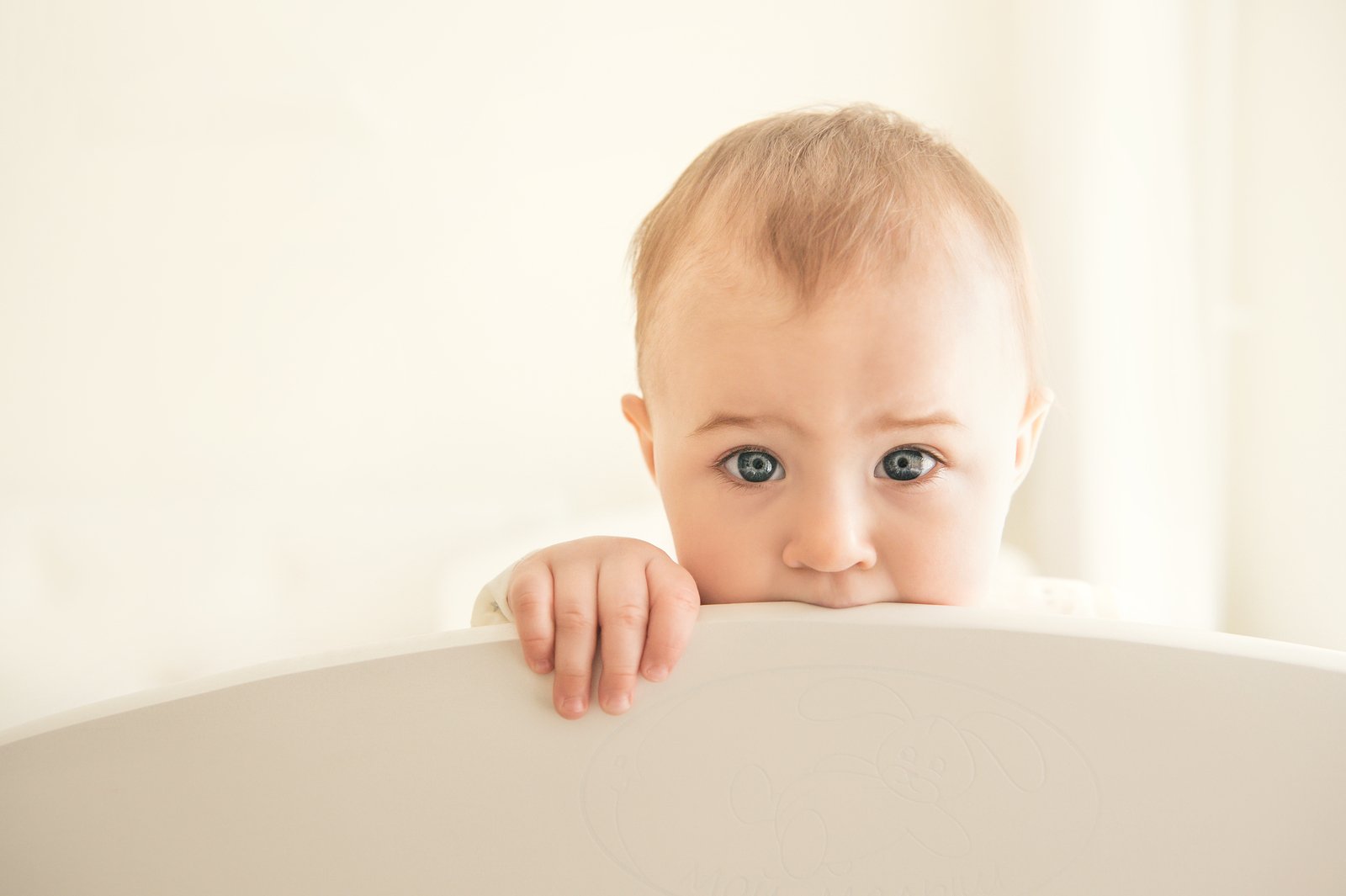A Parent’s Guide to Teething – Everything You Need to Know

Teething is an important developmental milestone! As your baby’s teeth come in, he or she will be able to enjoy a wider variety of foods and will be able to start an oral health regimen. While teething will not cause your baby too much discomfort, many parents are able to tell when their baby is teething. Keep reading to learn more about a normal teething timeline, signs and symptoms of teething, and easy ways to soothe your baby’s sore gums.
When Do Babies Start Teething?
Most babies get their first tooth when they are between 6 and 10 months old, but some start teething as early as 3 months of age or as late as 15 months. Genetics may play a factor in the eruption of your child’s teeth. If a parent got their teeth early or late, the baby’s teeth may follow suit. Premature babies may also start teething later in life than full-term babies.
Normal Teething Timeline
Pediatric physicians and dentists note that baby teeth tend to come in pairs every two months at first, with the final sets of teeth coming in about every four months. As a result, your baby’s incisors, or front teeth, will erupt in stages:
- At 6 months you can expect to see the first two central incisors in your child’s lower jaw.
- At 8 months, the top central incisors come in.
- At 10 months, the lateral incisors will emerge in both the lower and upper jaw.
After your child turns one year old, you can expect your child’s first molars at around 14 months, canines at 18 months, and second molars at 24 months. Don’t be concerned, however, if your child’s baby teeth don’t arrive exactly on schedule. Every baby is different and your pediatrician will be able to let you know if there are any causes for concern. To schedule your child’s first dental appointment, please click here.
How Long Does Teething Last?
From start to finish, teething typically takes about 18 months, although the time between each set of teeth will give you and your child periodic breaks during this process. If you notice that your baby is displaying teething symptoms for more than a week, yet no teeth actually erupt, consider talking to your pediatrician. He or she will rule out any other potential causes of your baby’s behavior.
Symptoms of Teething
Every baby responds differently to teething and some experience minimal discomfort. However, there are a few symptoms that you can look out for. These symptoms include:
- Irritability: Babies don’t necessarily understand why they are experiencing pain or discomfort and may become irritable or clingy.
- Trouble sleeping: If your child is uncomfortable, he or she may have a harder time sleeping at night.
- Swollen, sensitive gums: Changes in your baby’s gums, such as puffiness and redness can indicate that teething has begun.
- Drooling: Teething can stimulate a lot of drooling, which often starts for most babies between 10 weeks and 4 months of age.
- Ear pulling: You need to be careful with this one, because this can be a sign of an ear infection. However, the pain of teething can sometimes be experienced in the ear as well.
- Loss of appetite: Teething can have a negative impact on your baby’s appetite. If you have concerns, schedule an appointment to see your doctor.
What to Expect During Teething
What to expect during teething depends on your child’s personality and the amount of discomfort he or she experiences. Some babies are fussier and more in need of support and affection. When your child begins teething, it is important to be on the lookout for signs of infection or severe distress. If your baby has a low-grade fever during teething, continue to monitor his or her temperature and seek medical attention if it lasts for more than three days or reaches 101°F.
Baby Teething Relief
Your child may have sore or tender gums when their teeth begin to erupt. Fortunately, there are many at-home remedies you can try to alleviate your baby’s pain and help them through this process. Before you try any of the home remedies you find online or learn about from friends, please speak with your pediatrician.To learn more about teething, click here.
Rub Your Baby’s Gums
Many babies will seek out opportunities to chew or gnaw on anything that is hard, including furniture, crib railings, and toys. This pressure can hasten the teething process and offer pain relief. Another way to relieve your baby’s pain is to use a clean finger, teething ring, or wet gauze to lightly massage your baby’s gums for a few minutes.
Buy Teething Rings or Toys
Teething is hard but teething rings and toys can provide your baby with relief. To purchase a teething ring and toy, visit your nearest toy store or baby shop. You may also want to buy a few so that your child can pick his or her favorite. Make sure to avoid teething necklaces, bracelets, and anklets, which pose a choking hazard and can cause mouth injury and infection.
Apply a Cold Washcloth or Spoon
A washcloth or spoon that has been chilled in the refrigerator can provide quick relief from teething pain. Do not freeze the washcloth or give your baby ice as this can present a choking hazard. There are also a number of commercially available teething rings to soothe your baby’s gums. You may choose to buy a few of these toys and refrigerate them, or gently massage your baby’s gums with a cold fingertip or cold teething ring. You can do this for up to two minutes at a time, but be careful if your baby’s teeth have already erupted.
Choose Soft Foods
Another option to soothe your baby’s sore gums is to offer your baby cold, soft foods such as applesauce, yogurt, mashed sweet potato, and cottage cheese. Avoid giving your infant teething biscuits or frozen foods, such as carrots or fruit slices, which can break apart in your baby’s mouth and present a choking hazard. One trick to feed your baby is to use a silicone-covered baby spoon that has been lightly chilled. This allows your child to get the nutrition they need while having something to chew on.
Use a Soft Bristled Infant Toothbrush
Soft bristle infant toothbrushes can be used to massage your child’s gums during the teething process. Once their tooth has erupted, you can use a tiny amount of toothpaste to clean the tooth each day. Supervise brushing and flossing until your child can do it on their own. This capability usually starts at about the age of six. Over time, your child will learn the importance of a good oral hygiene routine.
Try Over-the-Counter Pain Relief
If home remedies don’t work, you may want to consider over-the-counter pain relief options such acetaminophen and ibuprofen products, which have been formulated for babies. If you are considering other over-the-counter remedies, please speak with your physician. The FDA warns against using any type of topical analgesic products to treat teeth pain, including prescription or over-the-counter creams or gels. Your pediatrician will be able to inform you about the safety and efficacy of each over-the-counter product.
How to Care for Your Baby’s New Teeth
When your baby’s mouth is just a gummy smile, you can use a wet washcloth or finger brush to wipe their gums and remove bacteria. Once your baby’s teeth are visible, pediatric dentists recommend using a small soft-bristled toothbrush moistened with water and a rice-grain sized amount of fluoride toothpaste to clean his or her teeth twice a day.
When Should I Schedule My Child’s First Dental Appointment?
The American Dental Association recommends scheduling your child’s first dental visit near or during his or her first birthday. During their first appointment, your dentist will be able to provide guidance on caring for your child’s teeth and identify any potential issues before they become larger concerns.
Final Word
During your child’s teething process, you may wish to consult with a pediatric dentist regarding an appropriate oral health program for your child. Finding a dentist that is a good fit for your child and taking them for regular checkups will help your child get comfortable with the dental office and learn great oral hygiene habits that they will carry into their later years. To find your nearest Gentle Dental location, please click here. We look forward to seeing you and your child soon!


